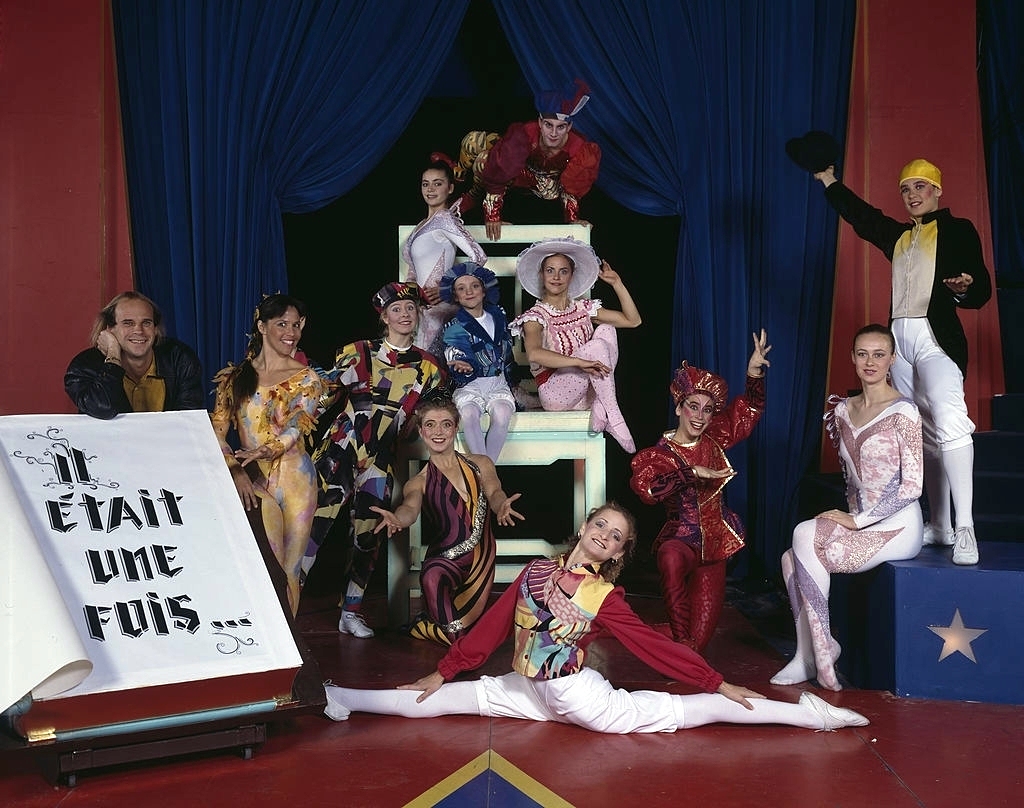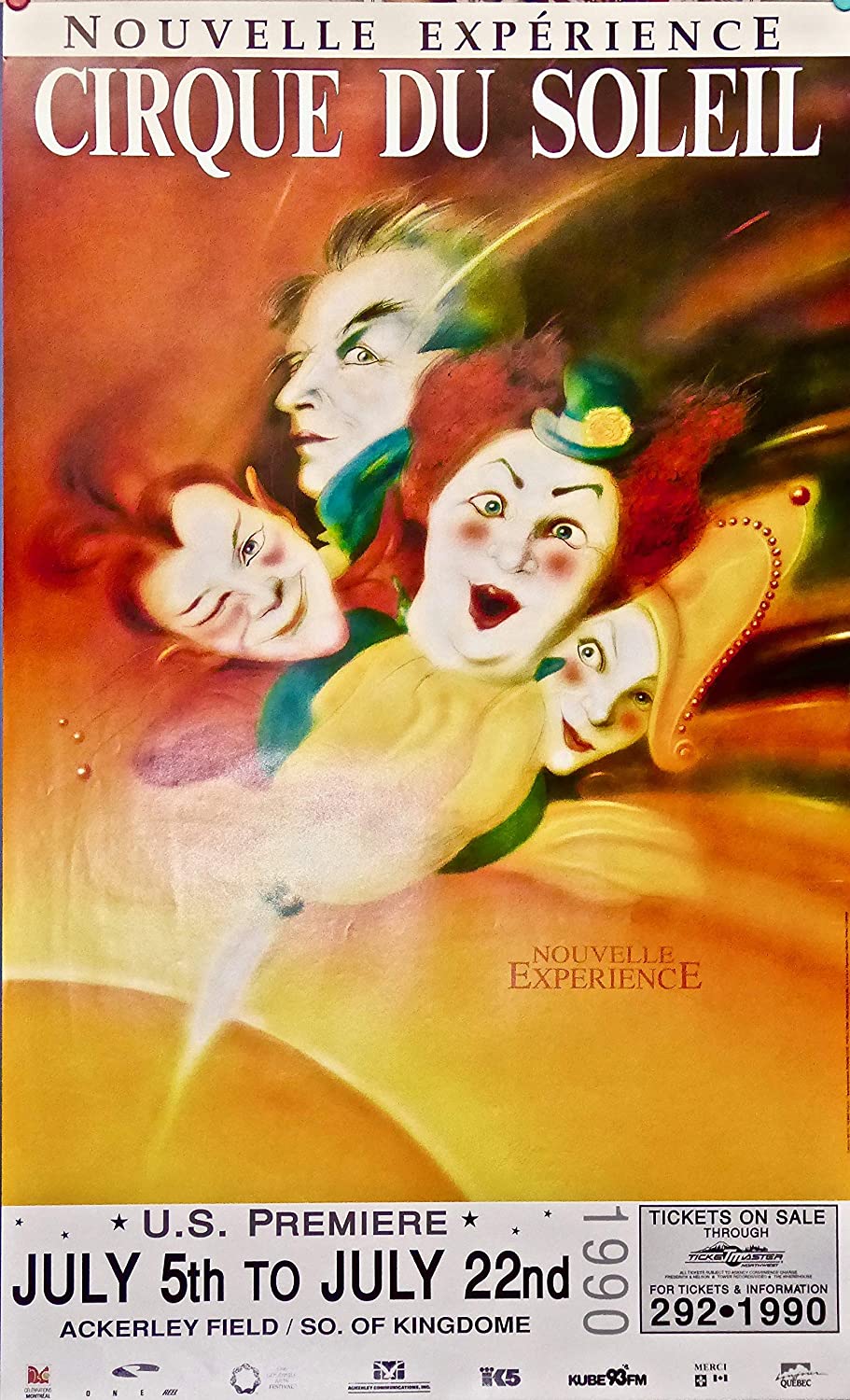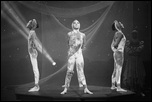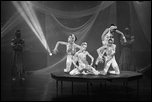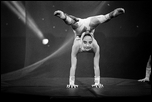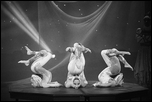

| |
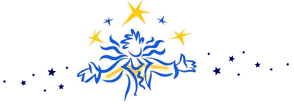 |
1990 |

A NEW LEVEL OF THEATRICALITY
"Behind each perilous leap there is a purpose, an intention, an individual,
an emotion." – Franco Dragone
With the reaction to 1989's version of Reinvente
not that great - "People said, 'this is just warmed over'," remembered Laliberte. It became
obvious that Cirque du Soleil had to do something totally new. That
"something" was called Nouvelle Expérience.
It would incorporate the best ideas from the aborted "Eclipse" project, and would
revolutionize the circus arts. But first...
ACROSS THE POND
Following Cirque du Soleil's explosive showing in Los Angeles and the subsequent
conquering of North America, the company set its sights on Australia, Japan, and
Europe. But each was met with a few challenges. While it would take some time for the
Cirque and Japanese interests to hammer out a deal (the Japanese tour, which was
supposed to have taken place this spring, is now indefinitely on hold due to the drop-off
in Japan's entertainment industry because of the one-year mourning period required by
Emperor Hirohito's funeral. Cirque would sign with Fuji in 1991 for a
unique tour the following year),
and planned an Australian tour of
Le Cirque Réinventé for early
1988 that fell apart late in the discussions (keeping the continent down-under Cirque-
free until Saltimbanco's visit in
1999), Cirque did attempt its first European Tour in 1990. London was the start of a
two-year tour that was supposed to take Le Cirque Réinventé
to Paris, Barcelona, and other European cities.
"We are a little bit nervous about Paris especially," said Danny Pelchat, Cirque's
new general manager and international advance man, in an interview. "Actually, very
nervous." Much was riding on the success of this tour; Cirque's successes in North
America kept multiplying their operating costs. The more people they drew, the bigger
they got, adding on acts and paying more for the venues where they pitched their tent.
As costs increased, so did the circus' dependence on larger markets which could sustain
such a large infrastructure. Those markets were found on the international scene,
prompting Cirque officials to admit bluntly that they had to succeed in Europe if the
Cirque was to survive. "We're shaking a bit in our boots -- but maybe that's good for
us," Guy Laliberté said.
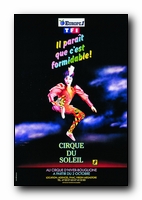 Taking a distinctively North American success story to more blasé audiences in
Europe was a tall order. The main reason the European trip was such a gamble was that
the Cirque had to chalk up an 85% attendance rate in a 1,600-seat arena to break even.
Under the 2,500-seat big-top used in North America, the break-even rate was just 65%. So
the Cirque had to fill a greater percentage of seats in Europe without the benefit of
the recognition factor it had garnered in North America. Asked what would happen if the
European stand was not a success, Pelchat replied: "That can't happen. Period." But if
the unthinkable did happen, "there are always back doors" to save the day. One option
would be to move the show to Italy or Germany, where success was more guaranteed. Why
not go there first? Because playing it safe was boring, they said. Not the Cirque du
Soleil way. "This is our breakthrough show," said artistic director Gilles Ste. Croix.
"The team is strong, experienced. Everyone in it knows how to do the Cirque du soleil.
It's the obvious choice to open up the European market."
Taking a distinctively North American success story to more blasé audiences in
Europe was a tall order. The main reason the European trip was such a gamble was that
the Cirque had to chalk up an 85% attendance rate in a 1,600-seat arena to break even.
Under the 2,500-seat big-top used in North America, the break-even rate was just 65%. So
the Cirque had to fill a greater percentage of seats in Europe without the benefit of
the recognition factor it had garnered in North America. Asked what would happen if the
European stand was not a success, Pelchat replied: "That can't happen. Period." But if
the unthinkable did happen, "there are always back doors" to save the day. One option
would be to move the show to Italy or Germany, where success was more guaranteed. Why
not go there first? Because playing it safe was boring, they said. Not the Cirque du
Soleil way. "This is our breakthrough show," said artistic director Gilles Ste. Croix.
"The team is strong, experienced. Everyone in it knows how to do the Cirque du soleil.
It's the obvious choice to open up the European market."
Unfortunately, Cirque du Soleil received mixed reviews in London.
The 2,000 strong audience may have clapped, whistled and cheered throughout the
inaugural performance, the newspaper critics' opinions were mixed, ranging from hostile
(the Daily Telegraph and the Guardian), to ambivalent (the Times), to ecstatic (the Daily
Mail). "This is a circus for people who don't really like circuses," said the Telegraph's
Charles Spencer. "A circus with all the sleaze and most of the danger taken out, a
sanitized, Disney-ish circus that will give no offence to anyone." (He did, however,
compliment many of the acts.) The Guardian's John Vidal asked "where's the beef beneath
the sugar and the frantic cheerleading confection, which whipped a loyal first-night
audience into something of a nationalist frenzy?" He went on to say "The true circus
skills on show, with a few notable exceptions like the man who cascades balls with his
mouth - are not technically remarkable, but this is a young company and they will develop."
The Times' Harry Eyres questioned Cirque du Soleil's claim to have reinvented the circus,
saying: "What it seems to be doing is redecorating the stripped-down anarchic face
new-wave circus with the gloss of the big old-fashioned family operations." He then
praised the clowns, the rhythmic gymnasts and the juggler. In contrast, the Daily Mail's
Jack Tinker adored the company: "A visual fantasie with brilliantly choreographed
acrobatics performed to excitingly orchestrated original music. "Miraculously, before
your eyes, a whole new art form emerges."
"We have found it hard," said Jean Heon. "There were two reviews in particular we
couldn't understand." Heon believes the circus was the victim of anti-French and anti-
American feelings on the part of certain British journalists. For them, he said,
Quebeckers and the French are one and the same. The British journalists also
considered the Cirque an American discovery, he said.
Cirque du Soleil didn't fair much better in Paris.
And that's even after changing the tagline of the show from "Le Cirque Réinventé" to
"Il paraît que ç'est formidable!" or something along the lines of "It's Great!". "We
could not arrive in Paris with a product unknown to them saying that we had reinvented
the circus!"
Although not a runaway success (the tour ran afoul of the Persian Gulf War, the
recession, blistering heat in London, and indifference in Paris), it was not a total
disaster. Approximately 161,102 spectators see the show. Cirque had hoped to tour
Nouvelle Expèrience following a
triumphant run by Réinventé, alas
it was not meant to be. Cirque would not attempt Europe again until
Saltimbanco made inroads in 1995.
A NEW EXPERIENCE
Meanwhile, in North America, audiences were treated to a brand-new experience from
Cirque du Soleil. It would incorporate the best ideas from the aborted Éclipse project,
and would revolutionize the circus arts. Nouvelle Expérience.
Guy announced the details of the production at a news conference on March 15, 1990.
This time, the circus would feature 39 performers from Canada and around the world,
including a Chinese juggler, Polish acrobats, a British tightrope walker and a French
trapeze artist. For the first time, Soviet performers would team up with the Cirque.
They would balance chairs, and perform in an aerial strap number and in a bar and
trampoline act. They joined some of the Cirque's Canadian stars, including four young
contortionists who won a gold medal last January at the Festival mondial du cirque de
demain (World Festival of the Circus of Tomorrow) in Paris. The contortionists, four
Quebeckers who range in age from 11 to 13, gave a short preview of their strangely
lovely act at the news conference. Anne Lepage, who won a silver medal at the same
festival, performed on the trapeze. Artistic director Franco Dragone said the show
will have as its theme "the meeting of life and a planet."
Nouvelle Expérience draws
inspiration from Jules Verne's "La Chasse du Météore" whereby the performers are
playing the parts of jewels spread around the Earth. Franco Dragone agreed
to return — albeit reluctantly — but only if he had full creative control
of the show's environment (something he did not have with previous efforts at the
Cirque.) One of the first things he did was to remove the curtain that
separated the artist from the audience, so that they would both feel part
of a larger show. Whereas in a traditional circus the artist could go past
the curtain and drop his role, Dragone had created an environment where
the artist had to remain in character for the full length of the production.
"Forget everything you've ever known or seen of the Cirque du Soleil, this new
show goes one bold step beyond," said circus representative Jean Heon. Only two of
the 39 performers are holdovers from the last show which played Montreal two years
ago. Gone are crowd-favorites such as contortionist Angela Laurier and clown Denis
Lacombe. Heon said the "frantic" nature of circus life almost guarantees there will
be a turnover of talent. "But our philosophy remains the same: To elevate circus into
art and to push circus artistry to new limits."
Montreal is the setting for the world premiere of Cirque's most successful
show yet, Nouvelle Expérience,
in a new big top. Constructed in Bordeaux, France, it has a capacity of 2,500, 700 more
than the old home. "The new tent is so large, the first time we saw
it we felt it was a cathedral," Mr. Ste-Croix said of the interior space,
which has the look of a huge blue beach ball. "It inspired us to create things
to fill that space."
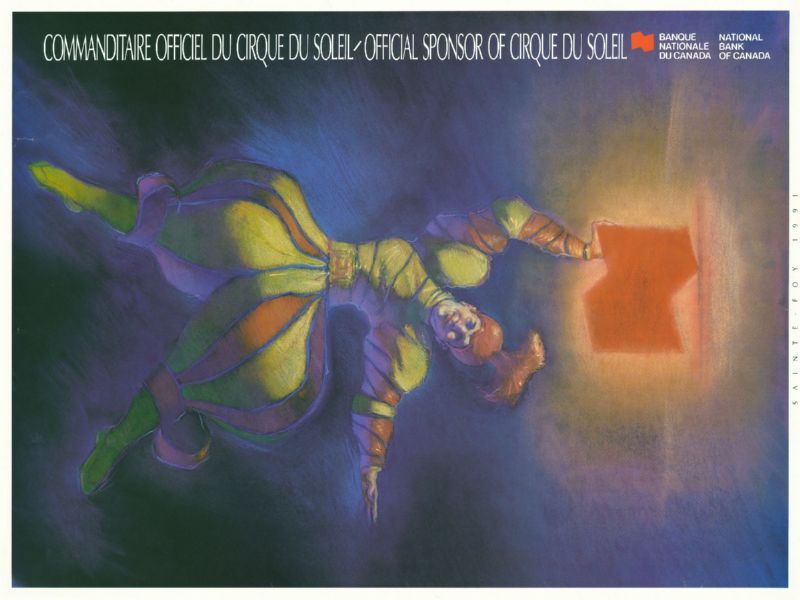 With this new production, Cirque du Soleil shatters all previous records for ticket
sales. Suddenly it begins to happen. The show, like a reluctant spirit hounded by a
posse of mediums, slowly reveals itself. An organic resonance emerges: each act finds
its place, a succession of moments as fleeting as they are eternal. Franco Dragoné's
impact is enormous: He pushes Cirque's theatricality to new limits, informing Cirque's
approach for many years to come. Key to Franco's indelible stamp will be his successful
creative association with set designer Michel Crête, costume designer Dominique
Lemieux, and choreographer Debra Brown, amongst many others.
With this new production, Cirque du Soleil shatters all previous records for ticket
sales. Suddenly it begins to happen. The show, like a reluctant spirit hounded by a
posse of mediums, slowly reveals itself. An organic resonance emerges: each act finds
its place, a succession of moments as fleeting as they are eternal. Franco Dragoné's
impact is enormous: He pushes Cirque's theatricality to new limits, informing Cirque's
approach for many years to come. Key to Franco's indelible stamp will be his successful
creative association with set designer Michel Crête, costume designer Dominique
Lemieux, and choreographer Debra Brown, amongst many others.


|
|
|
|


![]()





![[Back]](../images/arrow.gif)


